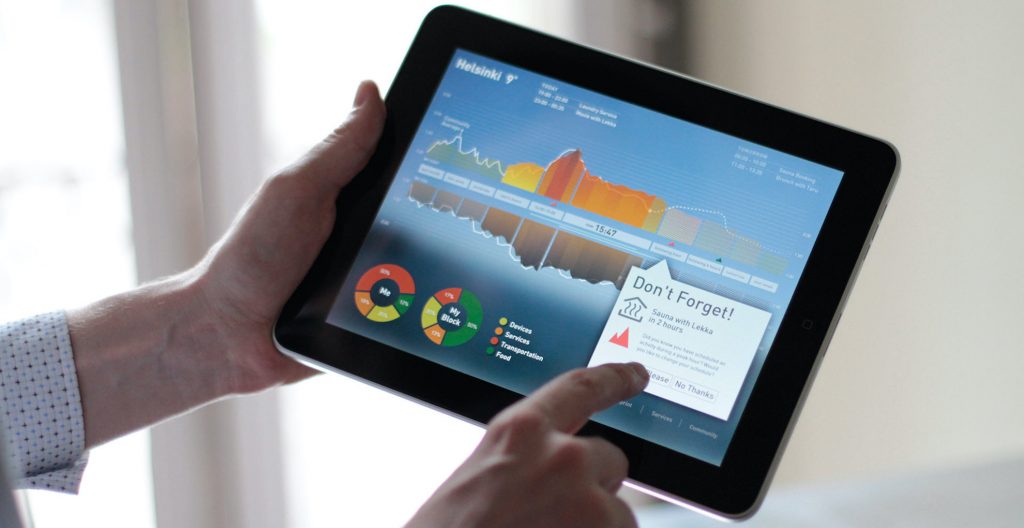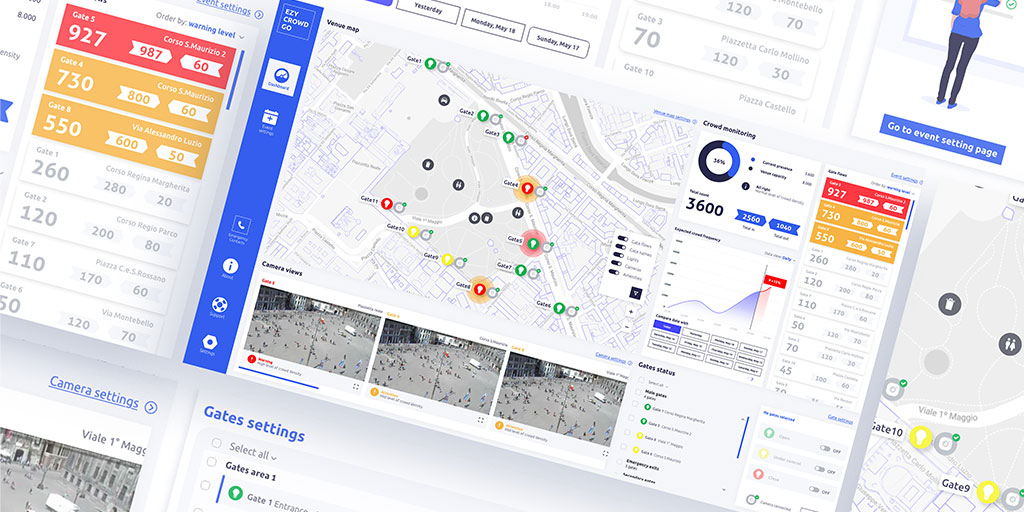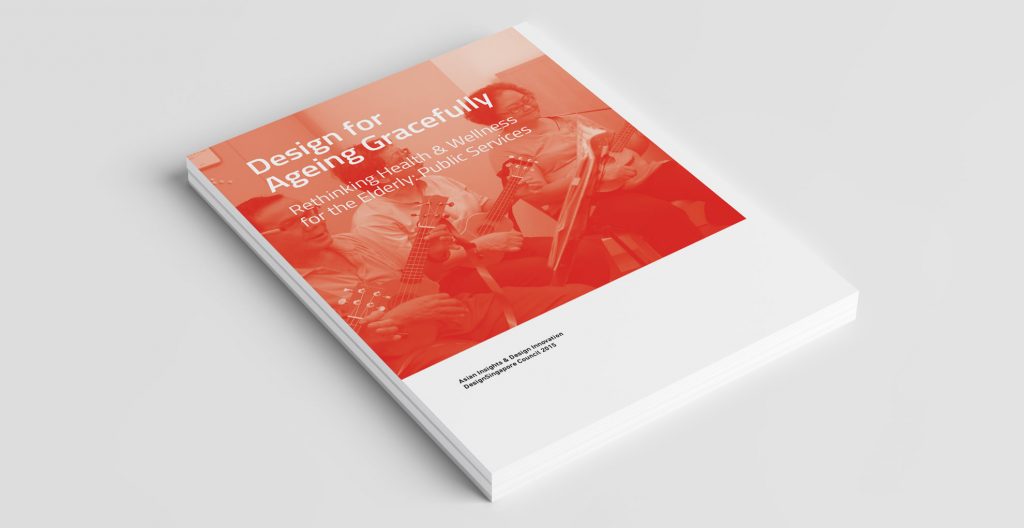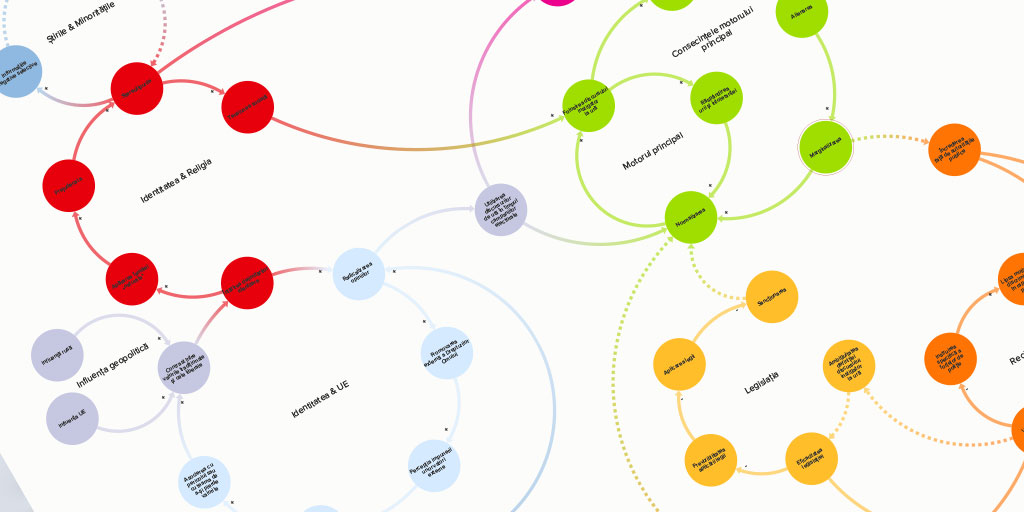Low2No: shaping the future of sustainable living

Low2No: shaping the future of sustainable living Sitra, the Finnish Innovation Fund Share In the former container port area of Helsinki, a building block named Airut (“messenger” or “herald” in Finnish) has risen to showcase innovative solutions for green developments worldwide. In collaboration with the engineering firm Arup, the architect studio Sauerbruch Hutton and Galley Eco Capital, Experientia has been a key contributor of this mixed-use development block, which houses around 500 residents, together with small-carbon-footprint services. 3 things to know Creating value through service design We designed energy demand management solutions and services and coordinated “mixed use” service offerings. The core of the service was enabling participatory solutions, such as games, competitions, workshops and websites for all its users. Behavioral change We analyzed drivers of behavioral change like environmental & life constraints, motivation and belief, social pressure and constraints, cultural framework, architectural and interface affordances, and designed fifty initial ideas for tools and services to facilitate behavioral change in Jätkäsaari Award winning Airut and Low2No have already won two awards – the 2011 Italian national prize for innovation in services and an acknowledgement prize in the 2011 Holcim awards for sustainable construction. Gallery In depth Service mix: Prototyping Information architecture Participatory design Service design Ethnography Useful links: Italian National Prize for Innovation in Services Blog post 2011 Holcim awards for sustainable construction Blog post Context The climate crisis requires new ways of designing and living our built environment, particularly in colder countries like Finland. Sitra, the Finnish innovation agency, launched an international competition for a low carbon housing and commercial building complex in Jätkäsaari, a reclaimed goods harbour to the west of central Helsinki, that aims to facilitate behavioural change towards more sustainable lifestyles. Challenge The competition was won in September 2009 by an international team led by global design, engineering and planning firm, Arup, providing engineering and sustainability services. The team also included Berlin-based Sauerbruch Hutton as lead architects and consumer behavior-change strategists Experientia. The building complex covers 22,000 square metres and provides new residences, office and retail space. Emissions are reduced through building design and performance, mobility systems and food production Research As the experience design partner, Experientia’s role has been to nudge the behavior of the people that visit, live and work at Airut, in a lasting sustainable direction. This nudge is being achieved through actively involving potential future residents and entrepreneurs in the development of their future environments, through the design of impactful, sophisticated and sustainable service offerings, and through the creation of behavioral change programmes. Design These interventions help to reduce energy demand and carbon emissions by enabling residents and workers to make better choices about their consumption while enjoying a very high quality of life. They are, in other words, “soft infrastructure” offerings that will complement the block’s “hard infrastructure” for energy and carbon management, including geothermal preheating and cooling, building integrated photovoltaics and a carbon neutral bio-heat product provided by the district heating network. Our specific deliverables have included a behavioral change framework, an award-winning service platform design, and a smart meter user interface design. Experientia has also worked on the planning and design of services, to create, within the Low2No project, a “Food Hub” (offering services related to the purchase, consumption and sharing of regional, organic food, an ethical and sustainable alternative to the products commonly offered in the Finnish market); an “Eco-laundry” (using highly efficient practices and detergents with a low environmental impact); and a communal, wood-fuelled sauna (an eco-friendly response to the presence of a private electric sauna in most Finnish homes). Impact Construction has been completed and the block is now occupied. From now, the sustainable ideals that govern its day-to-day life act as a model and example for the rest of Helsinki, Finland and the world. It has already won two awards – the 2011 Italian national prize for innovation in services (awarded to Experientia), and an acknowledgement prize in the prestigious 2011 Holcim awards for sustainable construction (awarded to the full design team). italian National Prize for Innovation in Services Blog post 2011 holcim awards for sustainable construction Blog post Related projects All Services Behavioral design Research and assessment Strategy Cities & InfrastructureSocial innovation ToNite: social innovation and urban regeneration in Turin, Italy Social innovation Turin Public Libraries, redesigning the cultural experience Social innovation COE, Strengthening access to justice through non-judicial redress mechanisms Go back to our portfolio
EZY Crowd Go, easy crowd guidance optimization

EZY Crowd Go, easy crowd guidance optimization EIT Digital Innovation Factory, European Research Project Share As a partner of the EZY – Crowd Go (an EIT funded project), Experientia co-designed wayfinding solutions to guide crowds during temporary events in public spaces. We conducted stakeholder research and led co-design activities with event managers and security professionals to identify new service opportunities, provide UX guidelines and design the prototype of the IoT dashboard. 3 things to know Clarify the needs and “jobs to be done” Investigate start-up MVP market interviewing stakeholders involved in the event management industry, to clarify needs, pain points and opportunities regarding the management and monitoring of crowds. Define the value proposition Using co-design methodology to identify a long term USP for safe exit strategies during temporary events. Future customers are both public authorities and private organizations that would benefit from using a system that guides event-goers to the least crowded exits. Design and validate the MVP solution Defining UX strategy and guidelines for visitor front-end exit guidance and designing a hi-fi dashboard prototype of the operational lights and sensors back-end IoT. Gallery In depth Service mix: Envisioning Prototyping Service design Context In the context of the European research project EIT (European Institute of Technology) Digital, Experientia co-designed wayfinding solutions to guide crowds during temporary events in public spaces. The IoT solution combines non-invasive WiFi crowd monitoring and crowd guidance directions using smart lights and sensors. Challenge During the initial and exploratory phase, we conducted stakeholder research and led co-design activities with event managers and security professionals to identify new service opportunities. During the design phase, we defined UX guidelines and designed a dashboard IoT prototype for security and facility managers to recommend behavior choices based on a data analysis of crowd-behavior. Research During the “early bird period” November-December 2019 Experientia research team conducted in-person and remote stakeholder interviews. The in-depth interviews allowed us to investigate the research question from a broad, comprehensive perspective. The main objective of the research was to investigate and identify opportunities for temporary event management. Model At the beginning of 2020 Experientia conducted a kick-off workshop with all the partners . We shared insights from the stakeholder and user research phase to inform and define the value proposition. Through participatory and co-design methodologies we facilitated the development of the next phases as well as conducted concept ideation activities. Design Experientia and the Polytechnic University of Milan used the findings from research to frame and define solutions for the design phase.In particular, we define the design guidelines for effective and inclusive crowd guidance and developed three innovative concept for addressing crowds during temporary events. Moreover, our interaction team design and validate the HI-fi prototype of the centralized dashboard, aim to collect crowd data and help operator make decisions and set the light system. Related projects All Services Behavioral design Research and assessment Strategy Cities & InfrastructureSocial innovation ToNite: social innovation and urban regeneration in Turin, Italy Social innovation Turin Public Libraries, redesigning the cultural experience Social innovation COE, Strengthening access to justice through non-judicial redress mechanisms Go back to our portfolio
Mapping the SPID registration journey, to improve the citizen experience

Mapping the SPID registration journey, to improve the citizen experience Department for digital transformation, Presidency of the Council of Ministers Share Driven by the necessity to improve and expand the national system of digital Identity called SPID, the Department for digital transformation, Presidency of the Council of Ministers selected Experientia to conduct a heuristic evaluation to assess the various end-to-end digital registration flows and qualitative research with Italian customers who had registered in the previous 6 months. The objective was to understand the critical needs and pain points in the overall service experience in order to provide UX guidelines and an updated strategic roadmap for improving current processes. 3 things to know A single “key” to access the public administration The government ambition was to provide citizens with a single access method to all the services offered by a multitude of organisations in the public administration. SPID applications grew more than twofold during the first COVID-19 lockdown. A multitude of registration options Our heuristic evaluation assessed 3 different registration processes for the 9 official SPID providers on both desktop and mobile. Some providers offered up to 6 different sign-up flows. People just wanted to avoid queueing The COVID-19 pandemics and the social distancing rules encouraged SPID citizens to sign-up using remote options even for ID validation. One of the strongest motivation to avoid analog ID validation was to avoid queuing in public offices. Gallery In depth Service mix: Design thinking Participatory design Service design Context Driven by the necessity to improve and expand the national system of digital Identity called SPID, the Department for digital transformation, Presidency of the Council of Ministers selected Experientia to conduct a heuristic evaluation to assess the various end-to-end digital registration flows and qualitative research with Italian customers who had registered in the previous 6 months. The objective was to understand the critical needs and pain points in the overall service experience in order to provide UX guidelines and an updated strategic roadmap for improving current processes. Challenge The objective of the project was to understand the critical needs and pain points in the overall service experience in order to provide UX guidelines and an updated strategic roadmap for improving current processes. Research The project started with stakeholder interviews to clearly outline the strategic objectives of the project and of the wider SPID system. We conducted an heuristic evaluation about the UX of requesting SPID to identify major issues in the mobile and computer-based subscription experience. Followed by in-depth interviews with 18 Italian citizens to better understand their overall experience in the subscription and use of the SPID system. Design The analysis of combined research outcomes enabled us to identify crucial issues and opportunities for subscription and service improvement. The recurring patterns of customer expectations and behaviours allowed to build 4 customers journeys based on 4 customers profiles. During a participatory workshop with relevant internal stakeholders, we validated and prioritized opportunities to improve the current UX registration experience and systemic opportunities to support the growth and flexibility of the SPID system for the years to come. Related projects All Services Behavioral design Research and assessment Strategy Cities & InfrastructureSocial innovation ToNite: social innovation and urban regeneration in Turin, Italy Social innovation Turin Public Libraries, redesigning the cultural experience Social innovation COE, Strengthening access to justice through non-judicial redress mechanisms Go back to our portfolio
Singapore: a city for people aging gracefully

Singapore: a city for people aging gracefully DesignSingapore Council Share DesignSingapore Council asked Experientia to explore health and wellness for the elderly in the Singaporean public sector. We conducted ethnographic research and participatory design workshops, as part of a drive to develop design-led innovation for the health industry. 3 things to know Design ethnography and service design Experientia explored current healthcare experiences of the aging population in Singapore through design ethnography identify opportunities for design-driven innovation in public healthcare. We identified opportunity areas for design-driven innovation in the Singaporean public healthcare space to help Singapore create the right conditions to support a rapidly aging society. Interactive map of findings The interactive map allows people to browse the personas alongside field research videos, that communicate the research findings in the participants’ own words. Long lasting impact The findings have been incorporated in the Health Ministry’s ongoing Action Plan For Successful Ageing, and guided the development of a new residential impact. Gallery Singapore is proactively addressing the problems of a rapidly aging society We explored what is like to grow older in Singapore today, carrying out contextual interviews and shadowing with elderly people, their carers, and people with the healthcare industry. In participatory design workshops with Singaporean stakeholders, we introduced experience design guidelines and created concepts and strategies to improve the elderly healthcare system in Singapore. Our 8 personas show different experiences of aging and using the healthcare system in Singapore. Our customer journeys maps show the typical issues the participants experiences as they tried to manage their health. In depth Service mix: Design thinking Policy development Envisioning Participatory design Service design Behavioral modeling Ethnography Useful links: Download the pdf English language Website External link Singapore press External link Press release External link Press article External link Press article External link Context By 2030, Singapore will experience a profound shift in its age demographics with the elderly population increasing by three times. This calls for a radical change in perspective on how care can be better delivered to the elderly. Challenge To prepare and plan for that change, The DesignSingapore Council’s Asian Insights and Design Innovation (AIDI) programme embarked on a Rethinking Health and Wellness for the Elderly project to look into developing design solutions that better meet the needs of the elderly in Singapore, and asked Experientia to carry out an extensive research and analysis project , including a workshop with participating public agencies and services from the Singapore healthcare system. Research The project started with an understanding of global trends in elderly healthcare services. This was then followed by a design ethnography study through interviews and shadowing – to gather deep qualitative insights into the habits and behaviours of the elderly and to identify trends, behaviors and gaps in the interaction between elderly people and the healthcare system. From the observations, we learned about how the elderly think, act and feel towards managing their health at home and their needs and wants. Experientia developed 8 personas to begin the process of designing for behavioural change and explore solutions like ageing-in-place, peer-to-peer support and community platforms to solve some of the elderly healthcare issues. Participatory workshops allowed stakeholders from the public to be part of this process generating 12 main user-centred design concepts. In two multi-day innovation workshops with healthcare and public service stakeholders, representatives from the healthcare industry and public sector joined Experientia and DesignSingapore Council in Singapore. Here we introduced the challenges the participants face on a daily basis, showing video clips from the research to reveal the human faces behind the research. The stakeholders developed service concepts that would suit the unique characteristics of Singapore. Design Experientia team designed an interactive map of findings, a rich database resource that invites stakeholders to explore and be inspired to innovate and design relevant solutions for the ageing population. The concepts were useful to guide Singaporean healthcare agencies to create strategies, policies and services. The results of the project were compiled in a handy publication for further use in Singapore and freely available for anyone. As part of the project, Experientia also worked with Singaporean agencies and ministries to devise community-focused concepts for elderly residents in the Kampung Admiralty residential block. Co-creation workshops prototyped key policy decisions on ageing, health and housing. Impact Experientia’s report recommendations were widely reported in the Singapore press and were integrated in the Government’s $3billion Action Plan for Successful Ageing (website – pdf – press release – press article). The Kampung Admiralty residential block has been completed. It incorporated many of the concept ideas that were co-created in the Experientia-lead workshops. Download the pdf English language Website External link Singapore press External link Press release External link Press article External link Press article External link Related projects All Services Behavioral design Research and assessment Strategy Cities & InfrastructureSocial innovation ToNite: social innovation and urban regeneration in Turin, Italy Health GoCare: Interactive dashboard for a better home hospitalization service Health Rare disease patient journey mapping Go back to our portfolio
COE, Strengthening access to justice through non-judicial redress mechanisms

COE, Strengthening access to justice through non-judicial redress mechanisms Council of Europe Share In recent years, we have all become aware of the threat hate speech poses to human rights, democracy and the rule of law. Developing effective strategies to address it has become a major concern for national authorities and civil society actors across Europe. The Council of Europe selected Experientia to map the hate speech mechanisms within some EU countries. 3 things to know The importance of stakeholders Meeting the different stakeholders was essential to understand what were the commonly shared problematics and the specific ones related to each actor. The inclusion of stakeholders in a workshop to define the prioritary issues to overcome was essential, though many different perspectives. A new approach Through meetings with experts, desk research and readings, the team outlined some of the specific aspects and actors contributing to the current situation of hate speech, both in public and private contexts. The team developed a systemic map whose aim is to outline the main mechanisms and factors (and their interconnections) leading to hate speech countries. Future directions and policies The data gathered was useful to map some actions undertaken (mitigating or balancing factors) to prevent and combat hate speech, but also to grasp some early signals of potential future initiatives having an impact on Hate Speech. Gallery In depth Service mix: Envisioning Ethnography Context The Council of Europe selected Experientia to map the hate speech mechanisms within some EU countries. In recent years, awareness has been raised of the threat hate speech poses to human rights, democracy and the rule of law. Challenge Developing effective strategies to address it has become a major concern for national authorities and civil society actors across Europe. Such strategies should enable member states to significantly reduce the incidence and spread of hate speech, while respecting freedom of expression. Experientia mapped the hate speech mechanism and its involved variables through an extensive system map that helped to identify the gaps to fill in the legal framework, in the local services and in the collaboration between public authorities, citizens and politics in the countries that were part of the project. Research During the first phase of the project, Experientia collected and went through a number of documents and reports provided by the local consultants in each country: to build familiarity with the topic. The team went on with the Stakeholder Interviews and took part in a formative workshop session held by the Council of Europe. The stakeholder interviews allowed us to investigate the topic from different perspective and they helped to better detail the draft of the systemic map that was under definition. Design Experientia used the findings from the interviews and the documents to iterate the systemic map and write the systemic analysis report. In particular, we held two ideation workshop to create a space to define and agree upon potential opportunities and measures to be taken against the hate speech spreading and the leading institutions that will coordinate the development of such opportunities in the future. Related projects All Services Behavioral design Research and assessment Strategy Cities & InfrastructureSocial innovation ToNite: social innovation and urban regeneration in Turin, Italy Social innovation Turin Public Libraries, redesigning the cultural experience HealthSocial innovation Singapore: a city for people aging gracefully Go back to our portfolio
Turin Public Libraries, redesigning the cultural experience

Turin Public Libraries, redesigning the cultural experience CSI Piemonte Share CSI Piemonte partnered with Experientia to redesign the new digital experience for Turin public libraries: an ecosystem of more that 15 local libraries spread across the Turin area. Weekly design thinking workshops and co-creation activities with the local libraries team allowed us to gather all the different perspectives of a complex reality diversified among the territory. 3 things to know One website, more that 15 local libraries The website of the Turin public libraries (“Biblioteche Civiche Torino”) gathers all the information connected to more that 15 local libraries spread across the territory. Every library has its own audience, events, reading proposals, services and articles. Library directors highlighted the importance of each library: every user sticks to his neighborhood library rather than being a frequent visitor to all libraries. For this reason, creating sub-homepages for each library was important to support users in their usual behavior using the service. Design thinking workshops Design thinking methodology was applied in order to achieve a final website that was cohesive and could meet all the different needs among the complex and diversified contexts of the territory. Weekly meetings with the librarys’ selected tea allowed a step by step approach and the possibility to validate each part of the website with the stakeholder in charge of that service: events, programs and projects, children section, historical and local collections. A piece of an ecosystem The website is a part of a complex ecosystem composed of a catalog online and a digital lending platform. The two services (catalog and digital lending) are not located within the Turin public library website but instead in different domains. These three platforms have to recall each other’s contents and give the perception of a solid ecosystem. Information architecture methodology and content organization were necessary in order not to lose any pieces during product integrations. Gallery In depth Service mix: Prototyping Information architecture Participatory design Useful links: Biblioteche civiche torinesi External link Context The Turin Public library website had to be updated in terms of information architecture and prioritization of informations, as well as visual presence and new look and feel. The portal is the final stage of the “Rethinking Turin Civic Libraries” project, launched in 2019 on the occasion of the 150th anniversary of the founding of the Central Civic Library and supported by Intesa Sanpaolo. Research An extensive desk research allowed the team to spot best practices and common design patterns used by the most important library websites. A detailed content audit was necessary to be sure that each information of the “old” website would have been revised during the redesign. Weekly meetings with stakeholders and two specific workshops (directors of local libraries and kids&teens audience) were the key stages to came out with important insights that led the design choices. Design The redesign of the website was supported by information architecture and wireframes activities. The responsive website is designed with a mobile first approach and uses common design patterns, usability rules and accessibility. See here for the final outcome of the project. Biblioteche civiche torinesi External link Related projects All Services Behavioral design Research and assessment Strategy Cities & InfrastructureSocial innovation ToNite: social innovation and urban regeneration in Turin, Italy Social innovation COE, Strengthening access to justice through non-judicial redress mechanisms HealthSocial innovation Singapore: a city for people aging gracefully Go back to our portfolio
ToNite: social innovation and urban regeneration in Turin, Italy

ToNite: social innovation and urban regeneration in Turin, Italy EU’s Urban Innovative Action Program Share ToNite is an urban renewal project which aims to develop multidisciplinary solutions to manage public spaces and improve residents’ perception of security at night-time along the Dora River of Turin, Italy. 3 things to know Design ethnography and service design Experientia explored the current culture of security – with a focus on night-time – in two different areas along the Dora River through the involvement of key stakeholders, local communities and citizens. The ethnographic research consisted of in-depth interviews, explorative urban walks and an online questionnaire. Co-design with communities During different phases of the project, citizens were given the opportunity to co-define solutions to improve social cohesion and the perception of night-time security and liveability of public spaces. Develop a human-centered approach to data modeling Evidence from research on the culture and perception of security was used to inform the design of the technology infrastructure that supported the City of Turin on related topics and defined a call for innovative local social impact projects. Gallery Video https://youtu.be/m7EpFn8RZJ8?si=7iWAp3KUGBcdV1lNhttps://youtu.be/eV2wwPIay0Y?si=JIWahAXLsptvIxMG In depth Service mix: Design thinking Policy development Participatory design Service design Ethnography Useful links: Download the report Italian language Link to ToNite website About the project Context Urban Innovative Actions (UIA) is a Program of the European Union that provides urban areas throughout Europe with resources to test new and unproven solutions to address urban challenges. Although research on urban issues is well developed, potential solutions are not always put into practice because urban authorities are reluctant to use their money to test new, unproven, and hence risky ideas. Urban Innovative Actions offers urban authorities the possibility to take a risk and experiment with the most innovative and creative solutions. The main objective of UIA is to provide urban areas throughout Europe with resources to test innovative solutions to the main urban challenges, and see how these work in practice and respond to the complexity of real life. ToNite was a 3-year project. It ran in the 2019-2023 timeframe. Challenge The City of Turin, together with a range of partners including Experientia, participated in the 2019 call and won a €4.6 million grant with a project called ToNite. ToNite sought to create urban regeneration and to address urban blight and decline in selected areas along the Dora River through collaborative policies based on social empowerment, active participation of residents and stakeholders, and social and technological innovation. The main project partner was the Municipality of Turin. Other partners were: Fondazione Piemonte Innova, SocialFare, Engineering, the European Forum for Urban Security, Espereal Technologies and ANCI (the National Italian Association of Municipalities). Research Experientia was particularly engaged in activating communities in exploration activities, defining areas of opportunities and requirements to facilitate civic empowerment and technology-based social sensing. This allowed the City of Turin to implement multidisciplinary and co-designed solutions to improve the livability of public spaces and the perceived security of our communities. Experientia conducted ethnographic and social enquiry activities in target neighborhoods, engaged key stakeholders to understand the current culture of security (with specific focus on the night-time experience), and defined 33 new opportunities for the City. More than 500 residents were involved in the project exploration phase. Both qualitative and quantitative research methods were adopted, including 36 in-depth interviews, 5 exploratory urban walks, and an online questionnaire. Research outputs were strategic in informing subsequent project phases. Both Opportunity Mapping and Persona Modelling were used to guide co-design processes for innovative and impact-oriented services for the target area. Design We supported project partners in working with communities to co-design opportunities for urban regeneration and services to improve social cohesion and the perception of security and liveability of public spaces at night-time. The results led the City of Turin in defining a call for innovative social impact projects. 19 impact-oriented and sustainable projects were funded and supported by dedicated acceleration programmes. Insights from our qualitative inquiry with citizens and city representatives also helped the team in developing an improved and integrated technology infrastructure to understand and analyze urban insecurity phenomena and to provide overall intelligence. Within the acceleration programme conducted by different partners, Experientia supported the projects in developing their service model with dedicated sessions and service design tools, delivering 19 Service Blueprints. The analysis of the overall ecosystem led to the co-definition of strategic guidelines for the City of Turin regarding the areas of intervention and priorities to develop and maintain a service ecosystem. Impact ToNite contributed to the physical regeneration of the Dora River, providing new urban furniture and regenerating unused spaces located in the area. The project intervened in two different areas along the Dora River with the aim was to understand and improve residents’ perception of night-time security and livability. The collaborative bottom-up process applied highlighted interventions, actions and services and models for residents and innovators. Download the report Italian language Link to ToNite website About the project Related projects All Services Behavioral design Research and assessment Strategy Social innovation Turin Public Libraries, redesigning the cultural experience Social innovation COE, Strengthening access to justice through non-judicial redress mechanisms HealthSocial innovation Singapore: a city for people aging gracefully Go back to our portfolio

